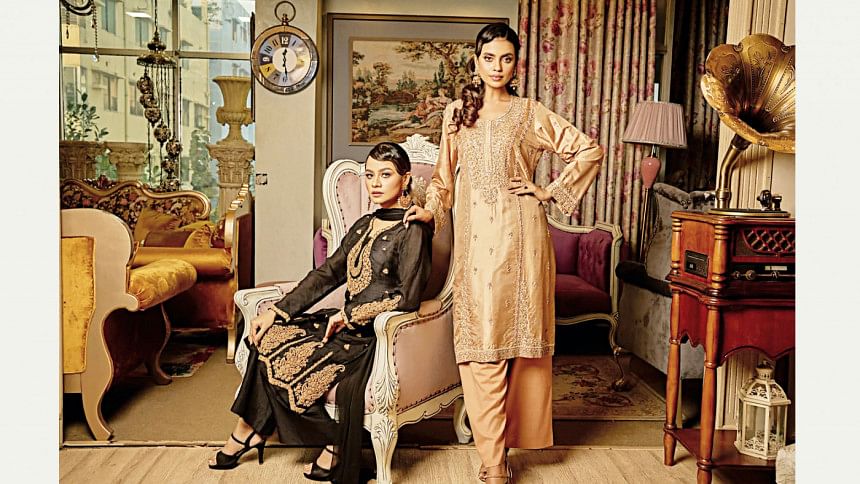Eid Elegance: 9 stylish trends to try!

Trends only serve as sources of inspiration. Personal style is nuanced, unique, and often timeless. In an era dominated by trends, microtrends, and fast fashion brands constantly releasing new collections, cultivating personal style holds significant value. However, staying informed about current trends can be beneficial in selecting elements to enhance our personal style. Here are the top 9 trends to draw inspiration from while shopping for Eid this season.
1. Globally, metallic clothing (e.g., golden, silver, copper, rusty gold/silver) has been trending for some time now. In Bangladesh and India, tissue saris have emerged as the most coveted item of the season, keeping up with the metallic garments trend. The tan, brown, and dark tones of beautiful Bengali women radiate from the shine of the metallic garment they adorn. Whether it's a tissue sari or a shimmery silk salwar kameez, women of any skin tone can't go wrong with metallic ethnic attire.
2. Along with tissue saris, Bandhni, Ajrak, pure silk Gadwal, Benaroshi Khaddi, and Silk Kanjivaram are among our top favorite types of saris from India. For those who can afford it, Jamdani with its intricate patterns and golden thread work stands as one of the crowning jewels in a sari lover's closet. While Tantuja saris enjoyed popularity only a few seasons ago, they have become slightly less favored, and Dhaka ladies are now opting for more traditional choices like Maslin, Rajshahi Silk, and Arong Silk when it comes to wearing Deshi saris.
3. Ajrak and Bandhni are two traditional textile techniques used to craft saris and Salwar Kameez. Currently, both prints are trending in Dhaka, reflecting their popularity in India as well.
4. Short kameez designs have taken a back seat unless they feature a well-thought-out design and aesthetic. Long kurtas and Salwar Kameez are now in vogue, with a preference for traditional long, churidar sleeves over dramatic, over-the-top sleeves. For bottoms, consider opting for palazzo-style pants, gharara, or sharara instead of the predictable pant salwar with your Eid outfit. Gharara and sharara sets, along with Angrakha and Anarkali dresses, continue to trend.
5. Benaroshi motifs are currently in vogue for Salwar Kameez. Mixed fabrics featuring Benaroshi motifs like Benaroshi Moslin and Benaroshi jorget are gaining popularity. High-quality Chinon silk is also a favored textile for Salwar Kameez this season.
6. In addition to the enduring popularity of shimmery metallic fabrics, floral prints remain on-trend, though they may feel slightly overused and lacking in innovation.
7. Kaftans offer a great alternative to saris and Salwar Kameez. One of the best aspects of kaftans is that they flatter all body types.
8. Moslin and Organza were highly popular a few years ago and have since become staples for small local luxury brands. Endi Silk and Sopura Silk, classic luxury fabrics, are favored by Bengali women and continue to be staples for local luxury brands and small boutiques.
9. While the Pantone color of the year for 2024 is Peach Fuzz, other colors like Hot Pink, Emerald Green, Berry Red, and Royal Blue are also trending for Eid outfits, despite Peach Fuzz being the official selection.
When it comes to ethnic wear, crafting a personalized aesthetic can pose a challenge. However, thoughtful selection of prints, textiles, jewelry, and accessories can help one cultivate a distinct signature style.
Building our personalized style doesn't have to break the bank. Like everything else, trendy items this season come in high-end, budget-friendly, and mid-range options. Mid-range tissue saris can range from BDT 10,000 to BDT 35,000. Alternatively, one can opt for a shimmery linen sari within the range of BDT 5,000 to BDT 6,000, offering a metallic gold appearance. The same variety exists for other types of saris. Pure Silk Gadwal typically costs around BDT 30,000, while cotton Gadwal is priced at BDT 7,000, and silk-cotton Gadwal ranges from BDT 10,000 to BDT 15,000. On the higher end, South Indian Kanjivaram saris span from BDT 30,000 to BDT 40,000 and beyond. Bangladeshi pure Silk Jamdani, featuring intricate patterns with golden or silver thread and more than 150 counts, may cost around BDT 100,000 to BDT 200,000. If one desires to invest in a high-end sari, saving up for it is advisable.
There are also alternative methods for making savvy purchases as well. This Eid, as in previous ones, banks and mobile financial services (MFSs) have partnered to entice women shoppers of clothing products, offering an array of attractive deals and discounts for purchases made through cashless payment methods.
Don't feel disheartened in your fashion journey if you cannot afford the most coveted items of the season. Remember that no matter how much or little money you spend on an item, it won't instantly make you fashionable. It's not just about what you wear, but how you carry yourself and how comfortable you are in your own skin that defines personal style. While wearing all the trendy items may give the appearance of perfection akin to a glossy magazine page, it's our flaws and limitations that make our personal style uniquely ours. Therefore, don't hesitate to embrace your individuality, even when adorned in the trendiest of items.

 For all latest news, follow The Daily Star's Google News channel.
For all latest news, follow The Daily Star's Google News channel. 



Comments